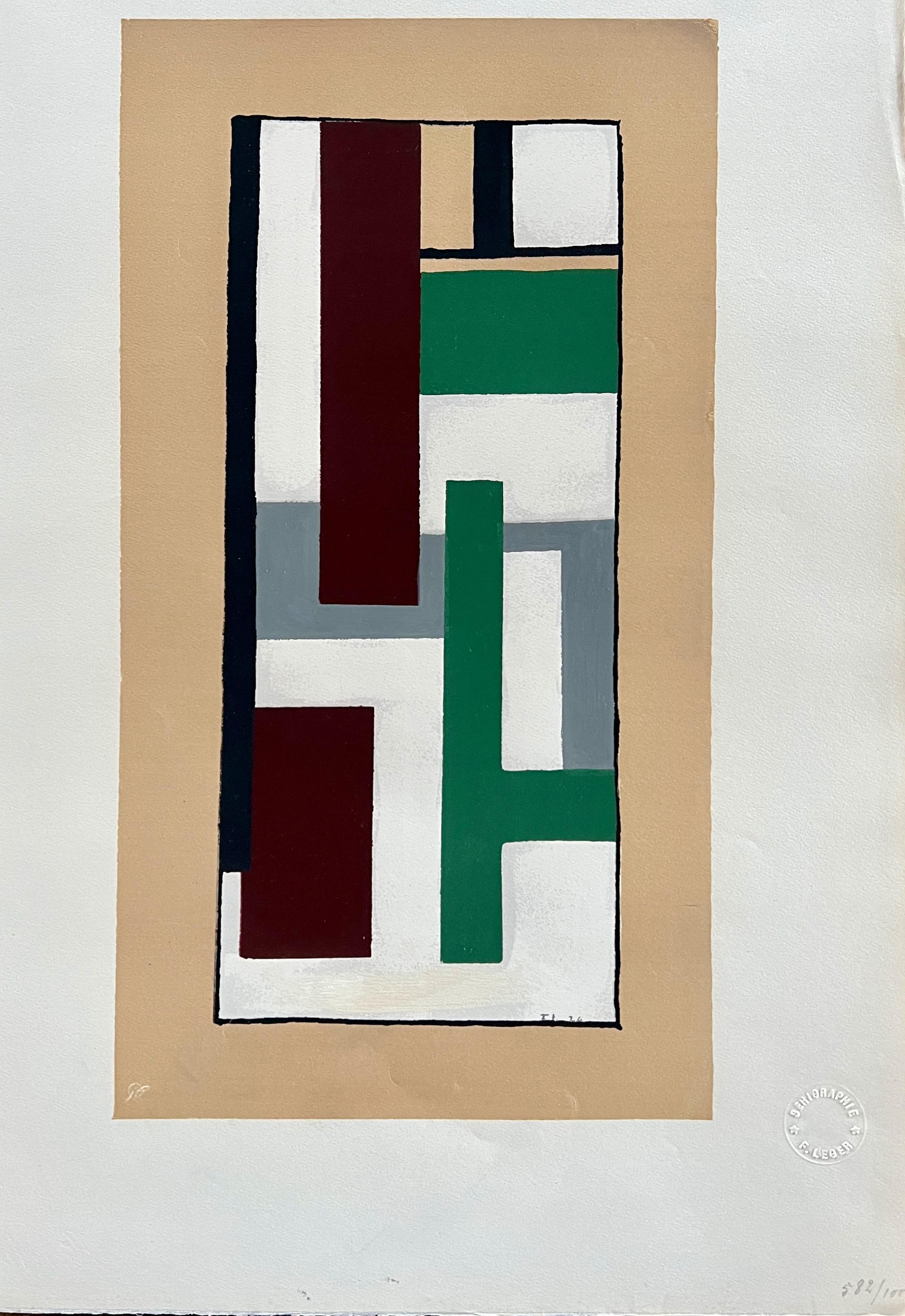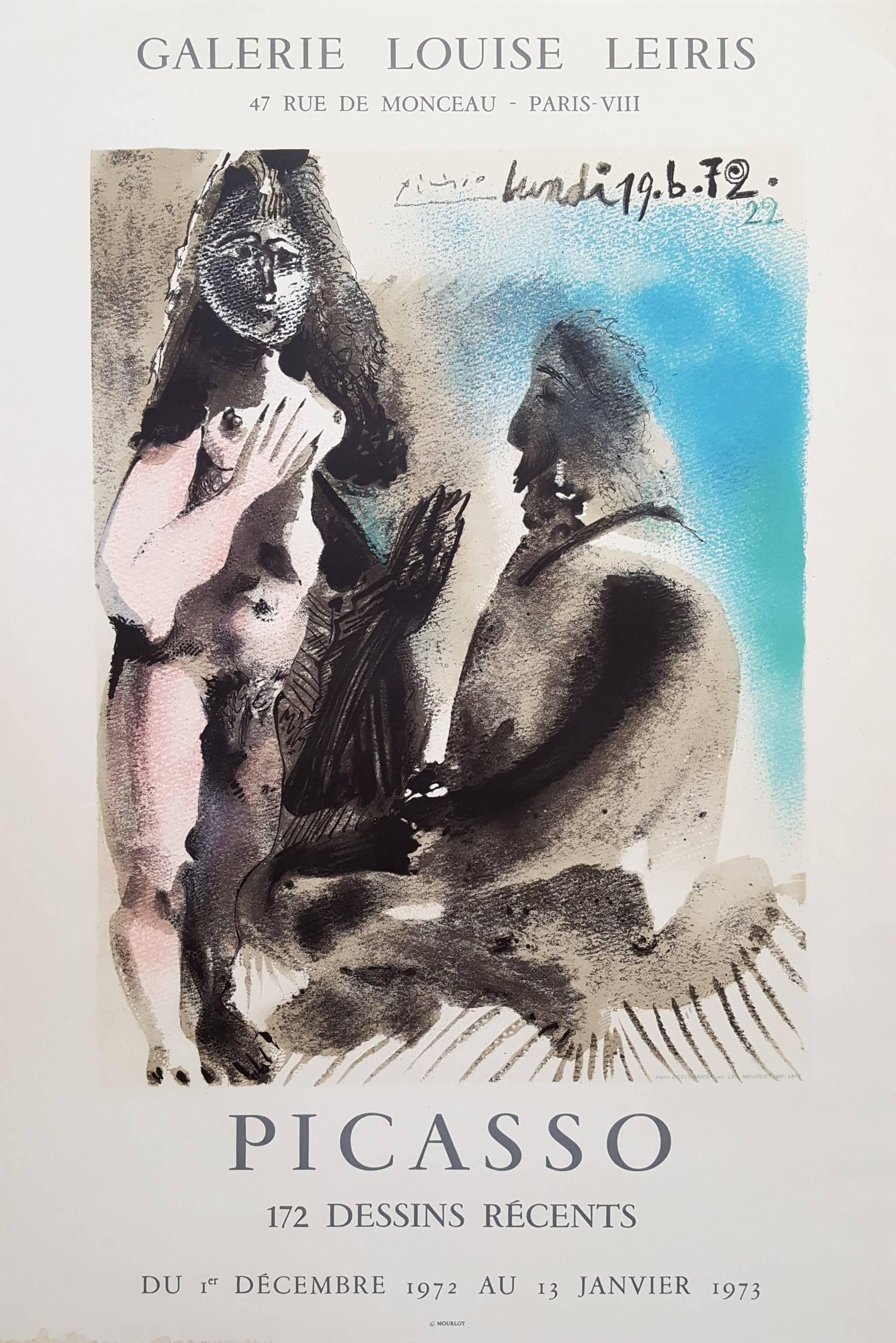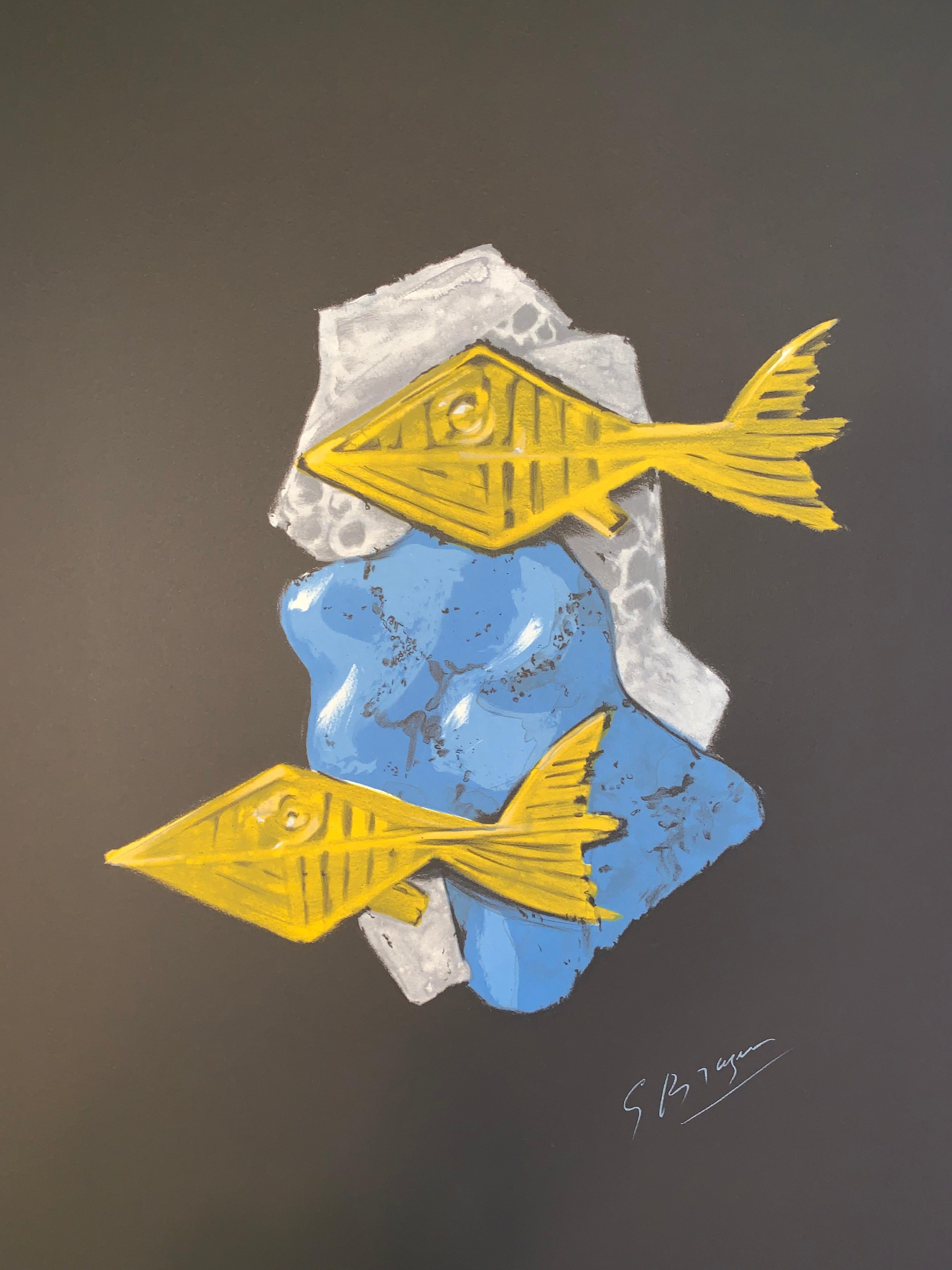Items Similar to "Sixieme Biennale de Peinture, " Original Vintage Lithographic Poster
Want more images or videos?
Request additional images or videos from the seller
1 of 10
(after) Pablo Picasso"Sixieme Biennale de Peinture, " Original Vintage Lithographic Poster 1966
1966
About the Item
"Sixieme Biennale de Peinture" is an vintage Picasso exhibition poster printed in 1966 by Mourlot. It depicts a Picasso painting from 1965 and advertises a Biennial exhibition of paintings at Menton Gallery in 1966.
28 1/4" x 18 7/8" art
30" x 28 5/8" frame
Catalogue raisonne: Czwitklitzer 284
Pablo Ruiz y Picasso, known as Pablo Picasso (1881 –1973) was a Spanish painter, sculptor, printmaker, ceramicist, and stage designer who spent most of his adult life in France. As one of the greatest and most influential artists of the 20th century, he is widely known for co-founding the Cubist movement, the invention of constructed sculpture, the co-invention of collage, and for the wide variety of styles that he helped develop and explore. Among his most famous works are the proto-Cubist Les Demoiselles d'Avignon (1907), and Guernica (1937), a portrayal of the German bombing of Guernica during the Spanish Civil War.
Picasso, Henri Matisse and Marcel Duchamp are commonly regarded as the three artists who most defined the revolutionary developments in the plastic arts in the opening decades of the 20th century, responsible for significant developments in painting, sculpture, printmaking and ceramics.
Picasso demonstrated extraordinary artistic talent in his early years, painting in a realistic manner through his childhood and adolescence. During the first decade of the 20th century, his style changed as he experimented with different theories, techniques, and ideas. His revolutionary artistic accomplishments brought him universal renown and immense fortune, making him one of the best-known figures in 20th-century art.
Prolific as a draftsman, sculptor, and printmaker, Picasso's primary medium was painting. He usually painted from imagination or memory, and worked in many different styles throughout his career. Although he used color as an expressive element, he relied on drawing rather than subtleties of color to create form and space. A nanoprobe of Picasso's The Red Armchair (1931) by physicists at Argonne National Laboratory in 2012 confirmed art historians' belief that Picasso used common house paint in many of his paintings.
Picasso’s work is often categorized into periods. While the names of many of his later periods are debated, the most commonly accepted periods in his work are the Blue Period (1901–1904), the Rose Period (1905–1907), the African-influenced Period (1908–1909), Analytic Cubism (1909–1912), and Synthetic Cubism (1912–1919).
In 1939–40 the Museum of Modern Art in New York City, under its director Alfred Barr, a Picasso enthusiast, held a major and highly successful retrospective of his principal works up until that time. This exhibition lionized the artist, brought into full public view in America the scope of his artistry, and resulted in a reinterpretation of his work by contemporary art historians and scholars.
Picasso was exceptionally prolific throughout his long lifetime. The total number of artworks he produced has been estimated at 50,000, comprising 1,885 paintings; 1,228 sculptures; 2,880 ceramics, roughly 12,000 drawings, many thousands of prints, and numerous tapestries and rugs.
- Creator:(after) Pablo Picasso (1881 - 1973, Spanish)
- Creation Year:1966
- Dimensions:Height: 30 in (76.2 cm)Width: 28.625 in (72.71 cm)
- Medium:
- Movement & Style:
- Period:
- Condition:
- Gallery Location:Milwaukee, WI
- Reference Number:
About the Seller
4.9
Platinum Seller
These expertly vetted sellers are 1stDibs' most experienced sellers and are rated highest by our customers.
Established in 1966
1stDibs seller since 2017
388 sales on 1stDibs
Typical response time: 1 hour
- ShippingRetrieving quote...Ships From: Milwaukee, WI
- Return PolicyA return for this item may be initiated within 14 days of delivery.
More From This SellerView All
- "Exposition Ceramiques Picasso, David Barnett Gallery, " Poster after P. PicassoBy (after) Pablo PicassoLocated in Milwaukee, WI"Exposition Ceramiques Picasso, David Barnett Gallery" is a poster made after Pablo Picasso. A Moon is shown, eyes connected by the nose and a ti...Category
1970s Cubist Figurative Prints
MaterialsOther Medium
- "Le Bouquet tout fait (The Ready-made Bouquet), " Lithograph after Rene MagritteBy René MagritteLocated in Milwaukee, WI"Le Bouquet tout fait (The Ready-made Bouquet)" is a color lithograph after a 1954 original painting by Rene Magritte. A bourgeois "little man" faces away from the viewer looking towards a fall forest. Flora, the goddess of flowers and season of spring, from Sandro Botticelli's "Primavera" is painted on the back of the man. This juxtaposes fall and spring. Art: 12 x 9.75 in Frame: 22.38 x 20.38 in René-François-Ghislain Magritte was born November 21, 1898, in Lessines, Belgium and died on August 15, 1967 in Brussels. He is one of the most important surrealist artists. Through his art, Magritte creates humor and mystery with juxtapositions and shocking irregularities. Some of his hallmark motifs include the bourgeois “little man,” bowler hats, apples, hidden faces, and contradictory texts. René Magritte’s father was a tailor and his mother was a miller. Tragedy struck Magritte’s life when his mother committed suicide when he was only fourteen. Magritte and his two brothers were thereafter raised by their grandmother. Magritte studied at the Brussels Academy of Fine Arts from 1916 to 1918. After graduating he worked as a wallpaper designer and in advertisement. It was during this period that he married Georgette Berger, whom he had known since they were teenagers. In 1926, René Magritte signed a contract with the Brussels Art Gallery, which allowed him to quit his other jobs and focus completely on creating art. A year later he had his first solo show at the Galerie la Centaurie in Brussels. At this show Magritte exhibited what is today thought of as his first surrealist piece, The Lost Jockey, painted in 1926. In this work a jockey and his steed run across a theater stage, curtains parted on either side. Throughout the scene, there are trees with trunks shaped somewhat like chess pawns with musical scores running vertically up their sides and branches sticking out from all angles. Critics did not enjoy this style of art; it was new, different, and took critical thought to understand, but The Lost Jockey was only the first of many surrealist artworks Magritte would paint. Because of the bad press in Brussels, René and Georgette moved to Paris in 1927, with the hope that this center of avant-garde art would bring him success and recognition. In Paris, he was able to become friends with many other surrealists, including André Breton and Paul Éluard. They were able to learn from and inspire one another, pushing the Surrealist movement further forward. It was also in Paris that Magritte decided to add text to some of his pieces, which was one of the elements that made his artwork stand out. In 1929, he painted one of his most famous oil works: The Treachery of Images. This is the eye-catching piece centered on a pipe. Below the pipe is written “Ceci n’est pas un pipe,” which translates to “This is not a pipe.” This simple sentence upset many critics of the time, for of course it was a pipe. Magritte replied that it was not a pipe, but a representation of a pipe. One could not use this oil on canvas as a pipe, to fill it with tobacco and smoke it. Thus, it was not a pipe. In 1930, Magritte and Georgette moved back to Brussels. Though they would travel to his exhibitions elsewhere, their home going forward would always be in Brussels. Magritte had his first American exhibition at the Julien Levy Gallery in New York City in 1936 and his first show in England two years later in 1938 at The London...Category
2010s Surrealist Figurative Prints
MaterialsLithograph
- Homage a Leonardo d'Vinci (Battle Scene I from De La Bataille Vol. I)By Claude WeisbuchLocated in Milwaukee, WIArt: 17" x 23 1/4" Frame: 27 5/8" x 33 7/8" Original color lithograph (VIII/L) Signed lower right. This original Weisbuch lithograph comes from th...Category
1970s Animal Prints
MaterialsLithograph
- "La Reconnaissance Infinie (The Infinite Recognition)" Litho after Rene MagritteBy René MagritteLocated in Milwaukee, WI"La Reconnaissance Infinie (The Infinite Recognition)" is a color lithograph after the 1963 painting by Rene Magritte. Two of Magritte's bourgeois "little men" stand in the sky. Both look away from the viewer talking to each other in the typical outfit of Magritte's men, black trench coats and bowler hats. Art: 15 x 18.25 in Frame: 26.25 x 29.88 in René-François-Ghislain Magritte was born November 21, 1898, in Lessines, Belgium and died on August 15, 1967 in Brussels. He is one of the most important surrealist artists. Through his art, Magritte creates humor and mystery with juxtapositions and shocking irregularities. Some of his hallmark motifs include the bourgeois “little man,” bowler hats, apples, hidden faces, and contradictory texts. René Magritte’s father was a tailor and his mother was a miller. Tragedy struck Magritte’s life when his mother committed suicide when he was only fourteen. Magritte and his two brothers were thereafter raised by their grandmother. Magritte studied at the Brussels Academy of Fine Arts from 1916 to 1918. After graduating he worked as a wallpaper designer and in advertisement. It was during this period that he married Georgette Berger, whom he had known since they were teenagers. In 1926, René Magritte signed a contract with the Brussels Art Gallery, which allowed him to quit his other jobs and focus completely on creating art. A year later he had his first solo show at the Galerie la Centaurie in Brussels. At this show Magritte exhibited what is today thought of as his first surrealist piece, The Lost Jockey, painted in 1926. In this work a jockey and his steed run across a theater stage, curtains parted on either side. Throughout the scene, there are trees with trunks shaped somewhat like chess pawns with musical scores running vertically up their sides and branches sticking out from all angles. Critics did not enjoy this style of art; it was new, different, and took critical thought to understand, but The Lost Jockey was only the first of many surrealist artworks Magritte would paint. Because of the bad press in Brussels, René and Georgette moved to Paris in 1927, with the hope that this center of avant-garde art would bring him success and recognition. In Paris, he was able to become friends with many other surrealists, including André Breton and Paul Éluard. They were able to learn from and inspire one another, pushing the Surrealist movement further forward. It was also in Paris that Magritte decided to add text to some of his pieces, which was one of the elements that made his artwork stand out. In 1929, he painted one of his most famous oil works: The Treachery of Images. This is the eye-catching piece centered on a pipe. Below the pipe is written “Ceci n’est pas un pipe,” which translates to “This is not a pipe.” This simple sentence upset many critics of the time, for of course it was a pipe. Magritte replied that it was not a pipe, but a representation of a pipe. One could not use this oil on canvas as a pipe, to fill it with tobacco and smoke it. Thus, it was not a pipe. In 1930, Magritte and Georgette moved back to Brussels. Though they would travel to his exhibitions elsewhere, their home going forward would always be in Brussels. Magritte had his first American exhibition at the Julien Levy Gallery in New York City in 1936 and his first show in England two years later in 1938 at The London Gallery...Category
2010s Surrealist Figurative Prints
MaterialsLithograph
- Homage a Leonardo d' Vinci (Three Figures Advancing from De La Bataille Vol. I)By Claude WeisbuchLocated in Milwaukee, WIArt: 17" x 23 1/4" Frame: 27 5/8" x 33 7/8" Original color lithograph (VIII/L) Signed lower right. This original Weisbuch lithograph comes from th...Category
1970s Contemporary Figurative Prints
MaterialsLithograph
- "Annette, " by Alberto GiacomettiBy Alberto GiacomettiLocated in Milwaukee, WI"Annette" is an original black and white lithograph by Alberto Giacometti. It depicts the bust of a nude woman in scratchy lines. Annette was Alberto's wife and frequently modeled fo...Category
1960s Minimalist Figurative Prints
MaterialsLithograph
You May Also Like
- Serigraphie Fernand LegerBy Fernand LégerLocated in Belgrade, MTThis print is part of my private collection. They were published in a numbered unsigned edition of 1000, and a signed edition of 200, printed by Serifraphie Fernand Leger, Paris and ...Category
Mid-20th Century Cubist Abstract Prints
MaterialsLithograph
- Galerie Louise Leiris (The Painter & His Model) Poster /// Pablo Picasso NudeBy (after) Pablo PicassoLocated in Saint Augustine, FLArtist: (after) Pablo Picasso (Spanish, 1881-1973) Title: "Galerie Louise Leiris (The Painter & His Model)" Year: 1972 Medium: Original Lithograph, Exhibition Poster on light wove pa...Category
1970s Cubist Figurative Prints
MaterialsLithograph
- Séléné - after Georges Braque - Lithograph - 1988 - Figurative PrintBy (after) Georges BraqueLocated in Sint-Truiden, BEColor lithograph after a gouache by Georges Braque from the edition of 398 published by Armand & Georges Israel in 1988. Printed signature. Artwork en...Category
1980s Cubist Figurative Prints
MaterialsLithograph
- Aegle - after Georges Braque - Lithograph - 1988 - Figurative PrintBy (after) Georges BraqueLocated in Sint-Truiden, BEColor lithograph after a gouache by Georges Braque from the edition of 398 published by Armand & Georges Israel in 1988. Printed signature. Artwork en...Category
1980s Cubist Figurative Prints
MaterialsLithograph
- Boréade - after Georges Braque - Lithograph - 1988 - Figurative PrintBy (after) Georges BraqueLocated in Sint-Truiden, BEColor lithograph after a gouache by Georges Braque from the edition of 398 published by Armand & Georges Israel in 1988. Printed signature. Artwork en...Category
1980s Cubist Figurative Prints
MaterialsLithograph
- Acheloos - after Georges Braque - Lithograph - 1988 - Figurative PrintBy (after) Georges BraqueLocated in Sint-Truiden, BEColor lithograph after a gouache by Georges Braque from the edition of 398 published by Armand & Georges Israel in 1988. Printed signature. Artwork en...Category
1980s Cubist Figurative Prints
MaterialsLithograph
Recently Viewed
View AllMore Ways To Browse
Vintage Catalogue
New York Art Directors Poster
Exhibition Posters Spain
French Painted Poster
Civil War Poster
Vintage German War Posters
Spanish Civil War Poster
Vintage French War Posters
Biennale Poster
Vintage Matisse
Picasso Rose
Vintage Pablo Picasso
Vintage Lithographic Posters
Matisse Poster
Exhibition Poster 1973
Pablo Picasso Blue Period
In The Manner Of Picasso
Cubist Painting 1973




